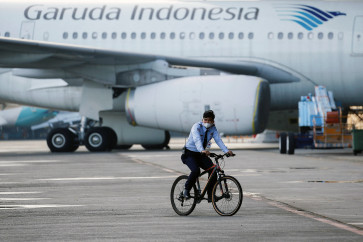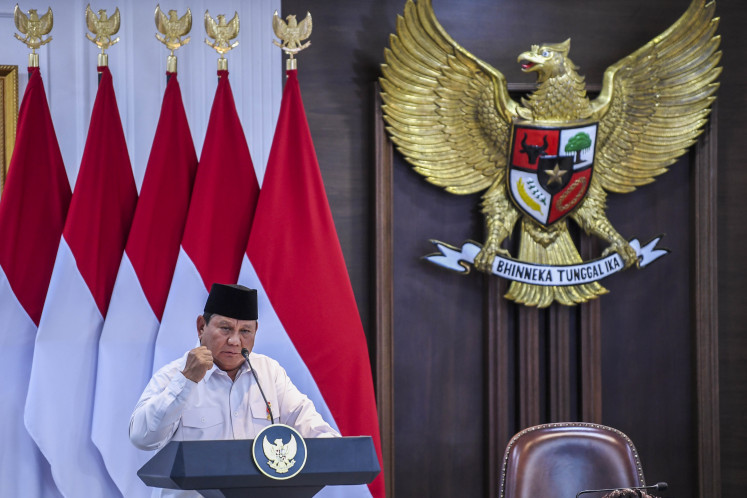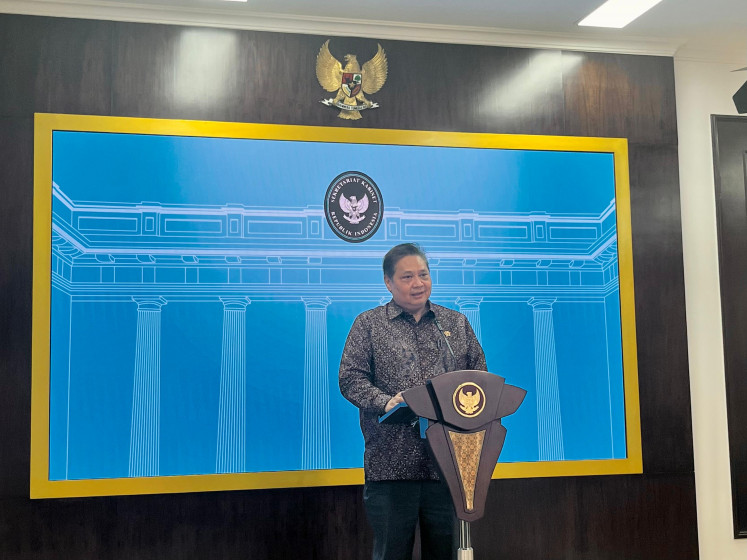US-China trade war impacts on ASEAN
ASEAN has played an important role in building prosperity in the region in its 50 years of existence
Change text size
Gift Premium Articles
to Anyone

A
SEAN has played an important role in building prosperity in the region in its 50 years of existence. ASEAN’s gross domestic product now stands at approximately US$2.5 trillion, making the expanded grouping the world’s sixth-largest economy and fourth-largest global trading power.
ASEAN nations have built regional production networks across many sectors, boosting their competitiveness in global markets and significantly reducing poverty. But while the current achievements and progress look good, there is a significant external threat at its doorstep: growing tension over trade between the United States and China.
Since the beginning of 2018, US President Donald Trump’s administration has announced a 30 percent tariff on imported solar panels, 25 percent tariff on steel and 10 percent tariff on aluminum in an attempt to curb its $375 billion trade deficit with China.
Following those measures, the US Trade Representative (USTR), an executive office of the US president, published a report that determined that the acts, policies and practices of the Chinese government related to technology transfer, intellectual property and innovation covered in the investigation were discriminatory and harmed US commerce.
According to the report, the US plans to apply the tariffs to about $50 billion worth of goods to punish China for its actions. Specifically, it plans to impose an additional 25 percent duty on 1,300 categories of goods.
While the list of goods excludes many Chinese-made consumer products, including clothing, shoes and toys, it includes cutting-edge technological products such as semiconductors, medical devices, aircraft parts and batteries, as well as other high-tech components of high value-added industries. In other words, the US action focuses on China’s high value-added and technological intensive products and is geared to go after China’s “Made in China 2025” plan.
In responding to the US action, China is targeting a narrower range of 106 types of US goods that were worth $50 billion in 2017, making up 38 percent of total US exports to China. Among the 106 products, the top three products from the US that China is targeting are aircraft ($16.3 billion), cars ($10.6 billion) and soybeans ($12.4 billion).
The list China published to retaliate against the US threat is shrewd. The list aims to put pressure on industries that have powerful influence on the American political system and significantly impact the bilateral trade value, including in the aircraft and soya beans industries.
Moreover, the targeted products come from politically sensitive states, such as cranberries from Wisconsin, home of US House of Representatives Speaker Paul Ryan, and bourbon from Kentucky, the home state of the US Senate majority leader, Republican Mitch McConnell.
It is worth noting that none of the tariffs will go into effect immediately. The US administration will hold a public hearing for US businesses on May 15. After the completion of the hearing process, the USTR will issue its final decision on products subject to the additional tariff.
ASEAN countries are deeply connected to the regional supply chain, serving as a major supplier of industrial intermediate inputs to China for further processing and re-exporting to western countries, including the US.
The US imposition of tariffs on Chinese products will potentially disrupt regional production networks that have developed over the past 30 years. In 2016, 12.4 percent of ASEAN exports went to China while 30.1 percent of those products were intermediate goods for the production of goods to be exported out of the country. In short, measures attempting to curb US imports from China have the potential to have an indirect adverse effect on ASEAN economies.
More specifically, ASEAN might be hit hard in the electrical and machinery sector. In 2016, the share of ASEAN electrical and machinery exports in proportion to the whole ASEAN export to China was around 36 percent while 41 percent of those exported products were used by China for further production processing. This threat is particularly relevant for Malaysia, the Philippines, Singapore, Thailand and Vietnam.
Despite this, the potential US-China trade conflict might also be positive for ASEAN economies. For example, if Apple products assembled in China suffer from the trade conflict, Vietnam could benefit because it is a major production base for Samsung Electronics Co., a major competitor to Apple.
At the same time, China might buy more from the region if it follows through on its threat to retaliate against American products. Slapping tariffs against American soybean oil, for instance, could increase demand for substitutes such as palm oil products, a major source of exports for Malaysia and Indonesia.
On the investment front, due to its location and cultural similarity, it is rational for businesses to relocate their investment to ASEAN economies to avoid getting caught in the middle of a US-China trade conflict.
There are at least two things that ASEAN governments and leaders can consider to uphold the current trading system and take advantage of opportunities that might arise from the trade conflict.
First, ASEAN should realize its significance, as a regional grouping, in global geopolitical dynamics and utilize that by shoring up support for trade. This argument is based on the fact that no country really dominates ASEAN, and no country in ASEAN would independently have the strategic geopolitical weight to be a force in the world.
ASEAN is the only way for the group of relatively small countries to be heard as a global middle power. Support for the existing global trading system can be accomplished by keeping ASEAN centrality in regional forums to advance regional cohesion, economic integration and international influence.
In practice, this strategic goal can be manifested by concluding the Regional Comprehensive Economic Partnership negotiation with its six main trading partners.
Second, ASEAN governments should double down on their commitment to push for structural reforms in their respective economies. While a trade war might have a negative impact on the global economy, there are also opportunities that could arise from the conflict.
For instance, the rebalancing of multinational investment might spur more investment into ASEAN economies and, in the end, boost the growth of ASEAN. Also, the US and China might buy substitute goods from ASEAN should they decide not to buy goods from one another.
In taking this opportunity, ASEAN needs to continuously improve its investment climate, improve its trade facilitation environment and continue its domestic structural reforms to improve its competitiveness.
______________________________
The writer is a research associate at the Economic Research Institute for ASEAN and East Asia. The views expressed are his own and do not reflect ERIA’s position.









